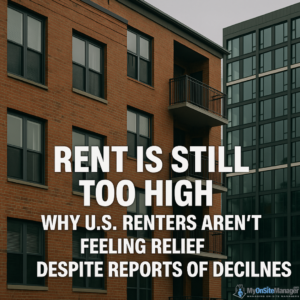After years of pandemic-driven rent increases, many renters hoped 2024 and 2025 would finally bring some financial relief. And while headlines tout slight declines in rent prices, the reality is that rent remains historically high in most parts of the U.S.—and for many, affordability is still out of reach.
A new report from Realtor.com, covered by FOX 10 Phoenix, reveals that despite modest declines in certain markets, the national median rent was $1,694 in March 2025, which is 20.2% higher than in March 2019, when the median rent was just $1,409. That’s nearly a $300/month jump in just six years—a massive increase, especially for working-class households.
Breakdown: What Renters Are Paying Now
Here’s what renters are facing as of March 2025:
-
Studio apartments: $1,407/month
-
One-bedroom units: $1,577/month
-
Two-bedroom apartments: $1,878/month
Even the most modest rental options—like studios—are creeping closer to $1,500/month, while larger units now hover near $2,000 in many regions.
These prices don’t even include additional costs like utilities, parking, or renters insurance, which can push total monthly housing expenses significantly higher.
So, Why Are Rent Prices Still So High?
1. Inflation Aftershocks
Although inflation has eased compared to its 2022 peak, many of the cost increases from that time have “stuck.” Housing is one of the stickiest components. Landlords who raised rents during the inflation surge have little incentive—or financial flexibility—to drop prices dramatically, especially if their own expenses have risen.
2. Ongoing Housing Shortage
The U.S. continues to face a severe housing supply shortage, particularly in affordable multifamily units. New construction has not kept pace with household formation. More people want to live independently—especially Gen Z and younger millennials—but there simply aren’t enough rental units to meet the demand.
3. Rising Construction Costs
Building more housing would help ease rent pressure, but developers are facing rising costs for materials and labor. The Realtor.com report notes that tariffs on imported steel and aluminum—key materials in multifamily construction—are pushing development costs even higher.
This makes it more expensive and less attractive for developers to build affordable housing, meaning the shortage persists.
4. Zoning and Regulation Barriers
In many cities, outdated zoning laws and lengthy permitting processes make it difficult to build new apartment complexes or convert commercial space into housing. Even when land and demand are available, bureaucratic red tape slows or blocks supply-side solutions.
5. Investors Prioritizing Profit
Many rental properties are owned by investment firms or corporate landlords who prioritize shareholder returns. These entities often raise rents aggressively—especially in gentrifying neighborhoods—pushing out long-time residents and reducing affordability across the board.
Who’s Most Affected?
Although the rent squeeze is national, urban renters, low-income families, and younger adults are bearing the brunt.
-
In cities like New York, Los Angeles, Miami, and San Francisco, rents remain well above the national average.
-
Even traditionally affordable areas—like parts of the Midwest or the South—have seen steep post-pandemic rent increases due to population shifts and investor activity.
-
Gen Z and Millennials, many of whom graduated during the pandemic or inflation spikes, are especially vulnerable. With wages not keeping up with housing costs, they face limited upward mobility and delayed milestones like homeownership.
The Long-Term Outlook: No Quick Fixes
The harsh truth is that there’s no quick or easy solution to America’s rental affordability crisis. Even if rent growth continues to cool slightly in the coming months, prices are unlikely to return to pre-2020 levels anytime soon. Here’s why:
-
New construction is slowing, not accelerating.
-
Tariffs and supply chain issues are raising costs for developers.
-
Federal rent relief programs introduced during the pandemic have mostly expired.
-
Wages are rising, but not at the pace needed to close the affordability gap.
What Can Renters Do?
While the macroeconomic forces are largely out of renters’ control, here are a few practical steps people can take:
-
Negotiate your lease: If your landlord is open to renewing at a similar rate, try negotiating longer-term lease stability.
-
Consider less competitive markets: Some smaller cities or suburbs offer better rent-to-income ratios.
-
Roommate arrangements: Splitting rent remains one of the most effective ways to manage housing costs.
-
Monitor local legislation: Get involved in local advocacy for rent control measures, tenant protections, or housing reform bills.
-
Track your credit and income: Having a strong rental profile can make you more competitive when applying for more affordable housing.
Conclusion: Declines Don’t Mean Relief
While rent prices may not be rising as fast as they did in 2021–2022, the current rates are still painfully high—and for many renters, unaffordable. The modest declines reported in Realtor.com’s study aren’t enough to reverse years of inflation and supply issues.
Until policymakers, developers, and communities work together to increase housing supply, remove zoning barriers, and control construction costs, the rental crisis will likely persist.
Renters should remain informed, proactive, and engaged in local housing issues—and most importantly, understand that “decline” doesn’t always mean “affordable.”
Source: FOX 10 Phoenix – “Rent remains high across the U.S. despite months of declines, study finds”

